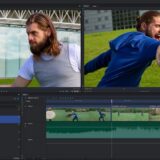Mastering the Art of Professional Video Editing: A Comprehensive Guide

In today’s digital age, video content has become a powerful tool for communication, entertainment, and marketing. Behind every captivating video lies the skillful hands of a professional video editor.
These skilled individuals possess the ability to transform raw footage into a compelling visual story. If you aspire to become a professional video editor, this comprehensive guide will provide you with the essential steps and insights to refine your craft and take your editing skills to the next level.
Introduction to Professional
Video Editing Video editing goes beyond simply piecing together footage. It requires a deep understanding of the medium and the ability to evoke emotions through visual storytelling. Developing skills such as attention to detail, creativity, and strong communication are crucial for success in this field.
Pre-production Phase
The pre-production phase sets the foundation for a successful video edit. Gathering and organizing raw footage is the first step. By reviewing and logging footage, you can gain a comprehensive understanding of the content, enabling you to make informed editing decisions. Analyzing the script or content helps in identifying key moments and desired visual and audio elements.
Post-production Phase
The post-production phase is where the magic happens. Creating a project timeline and assembling the rough cut are fundamental steps. Trimming and selecting the best shots, refining transitions, balancing audio levels, and incorporating music and voiceover enhance the overall visual and auditory experience. Additionally, visual effects, color correction, and grading play a pivotal role in enhancing the video’s aesthetics.
By the way, just recently we shot and edited a video about hydroponic systems. It took us very little time and the result was excellent.
Advanced Techniques and Tools
Mastering advanced techniques and utilizing specialized tools can elevate your editing skills. Learning multi-camera editing, motion graphics, and animation techniques allows you to create visually dynamic videos.
Understanding different video formats and codecs is crucial for optimizing the video’s quality and compatibility. Utilizing audio editing techniques, removing background noise, and adding audio effects enhance the audio experience. Exploring advanced software and plugins expands your creative possibilities.
Professional Workflow and Collaboration
Collaboration is key in the professional video editing world. Establishing clear communication channels with clients or team members ensures that you understand and meet their expectations.
Maintaining an organized workflow through proper file management and project backups safeguards your work. When delivering the final product, exporting the video in appropriate formats and resolutions ensures optimal viewing experience. Additionally, building a showreel or portfolio showcases your skills and attracts potential clients or employers.
Continuous Learning and Improvement
To thrive in the rapidly evolving field of video editing, continuous learning is essential. Staying updated with industry trends and techniques empowers you to stay ahead of the competition. Seeking feedback from experienced professionals and actively practicing new editing styles and effects helps you refine your skills and broaden your creative horizons.
How many hours does it take to edit a 10-minute video?
The time it takes to edit a 10-minute video can vary depending on several factors, including the complexity of the footage, the desired level of polish, the editing software and hardware being used, the editor’s skill level, and the availability of additional resources like graphics or special effects.
Generally, it is challenging to provide an exact timeframe as video editing can be a highly iterative and creative process.
However, as a rough estimate, for a 10-minute video, it may take anywhere from a few hours to several days to complete the editing process. This estimate includes tasks such as importing and organizing footage, assembling a rough cut, fine-tuning the edit, incorporating additional elements, refining the edit based on feedback, and finalizing the export and delivery.
Keep in mind that video editing is not just about the duration of the final video but also the complexity of the content and the desired level of quality. Projects with more intricate editing requirements, such as extensive visual effects or complex sound design, may require more time to complete.
Ultimately, the time it takes to edit a 10-minute video will depend on the specific circumstances of the project and the editor’s proficiency and efficiency in handling the editing tasks.
Conclusion
Becoming a professional video editor requires a blend of technical skills, artistic sensibility, and a passion for storytelling. By following the steps outlined in this guide and continuously striving for improvement, you can embark on a fulfilling journey in the world of professional video editing. Embrace the challenges, stay inspired, and create visual masterpieces that captivate audiences worldwide.



